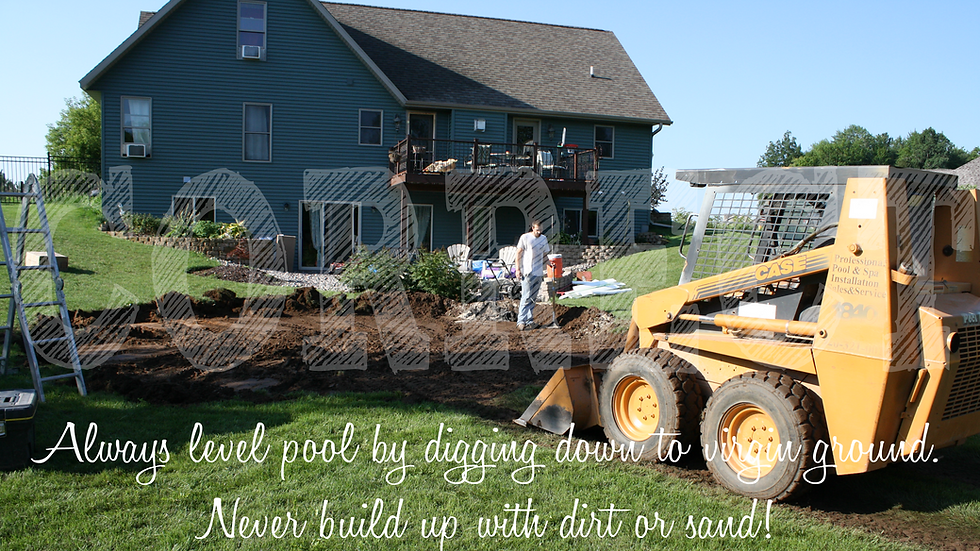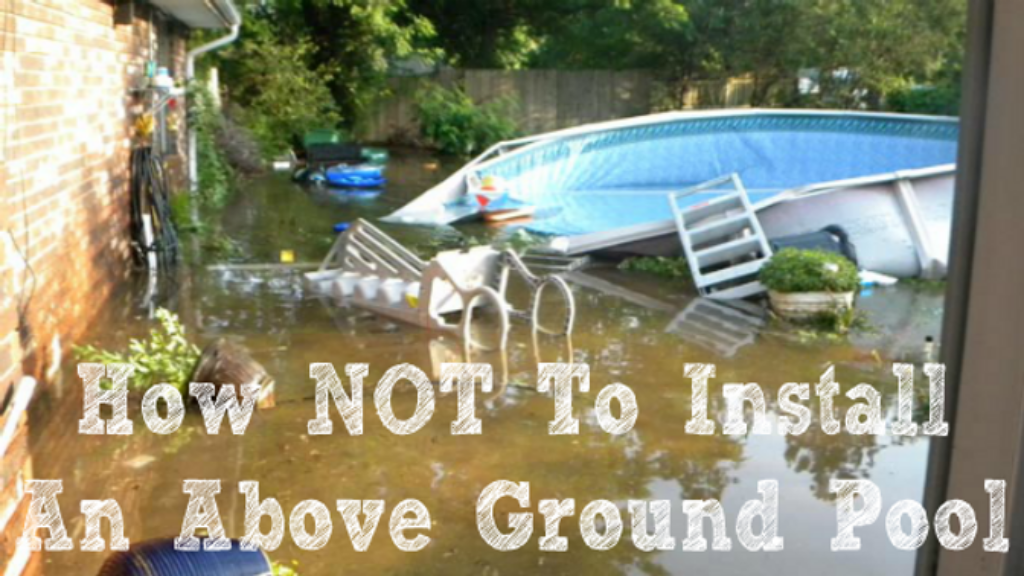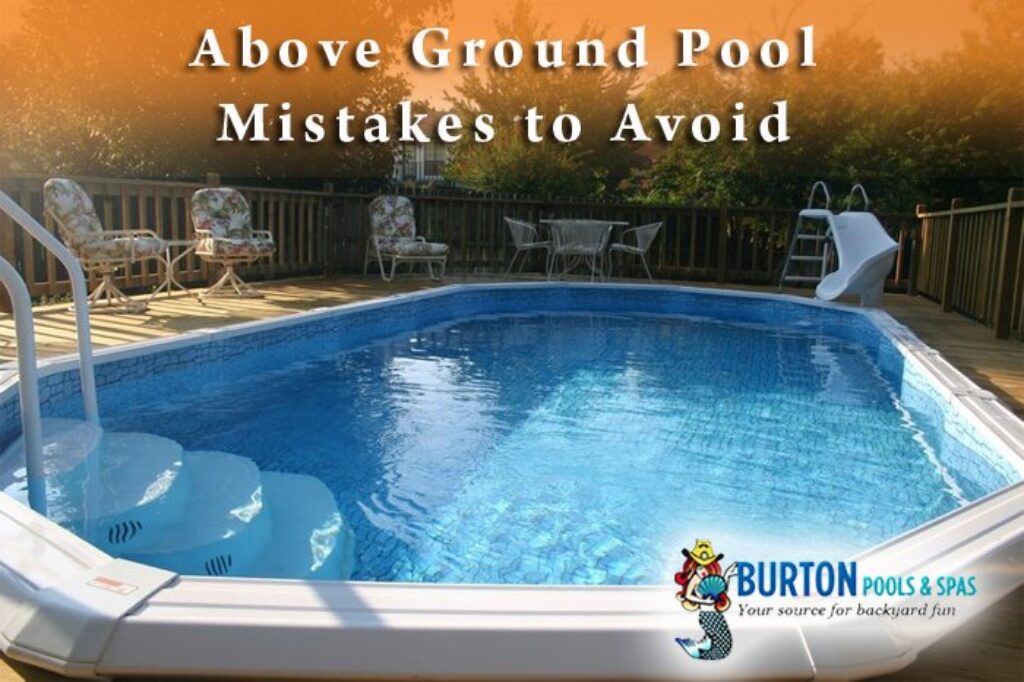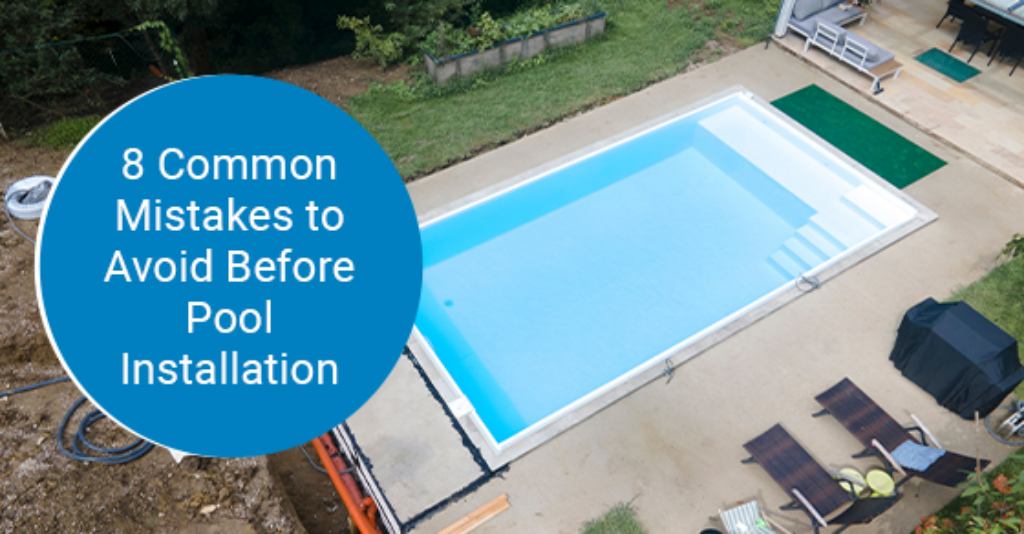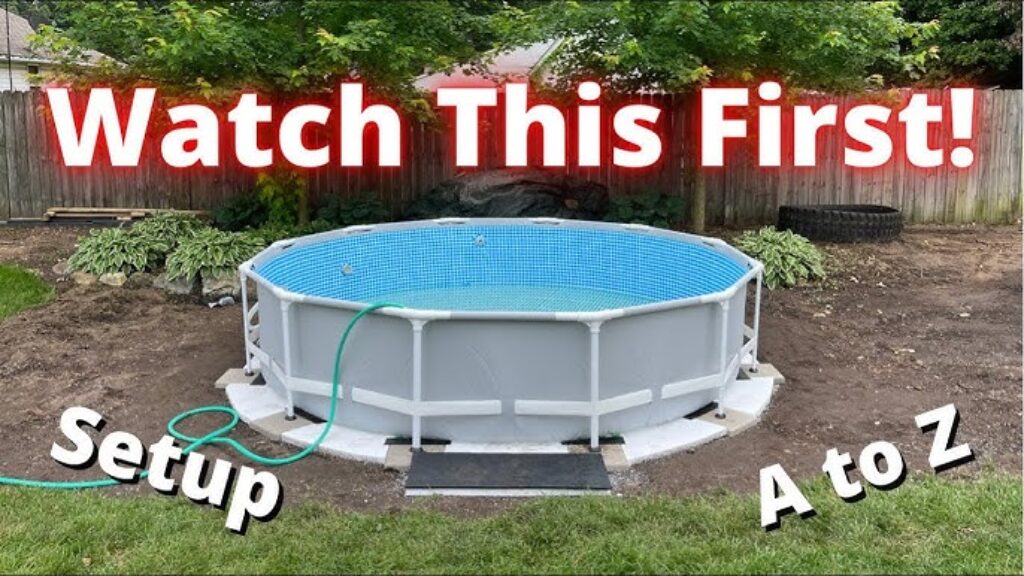Installing an above ground pool can be an exciting project that brings fun and relaxation to your backyard. However, it’s not without its challenges. In this article, you’ll learn about the common mistakes that many people make when undertaking this task, and how to avoid them. From choosing the wrong location to improper ground preparation, these blunders can lead to costly repairs and a less enjoyable pool experience. By following the tips and advice provided here, you can ensure a smooth and successful installation process, and start cooling off in your new pool in no time.
1. Choosing the Wrong Location
Not Checking for Underground Utilities
When choosing the location for your above ground pool, it is crucial to check for underground utilities. Failure to do so can result in costly damages and safety hazards. Before starting any digging or installation, contact your local utility companies to ensure there are no gas, electric, or water lines in the area. This simple step will help you avoid potential accidents and unnecessary expenses.
Ignoring Sun Exposure
Another common mistake is ignoring the sun exposure in your chosen location. While it may be tempting to place your pool in a shaded area to escape the scorching sun, it is important to remember that sunlight is necessary to keep your pool clean and free from algae. Additionally, excessive shade can lead to cooler water temperatures, making it less enjoyable for swimming. Consider the sun’s movement throughout the day and choose a location that receives a good amount of sunlight.
Setting Up on Unlevel Ground
An unlevel ground is a recipe for disaster when it comes to above ground pool installations. Not only will it affect the stability of the pool, but it can also lead to structural problems and water leakage. Take the time to properly level the ground before installing the pool. This may involve removing excess soil, using compacting tools, or even hiring a professional to ensure the ground is perfectly level. Investing time and effort into this step will prevent future headaches and ensure the longevity of your pool.
2. Improper Ground Preparation
Neglecting to Remove Debris
One of the most common mistakes when preparing the ground for an above ground pool is neglecting to remove debris. Before laying down the pool liner, it is essential to clear the area of any rocks, tree roots, or sharp objects that could potentially damage the pool. These debris can not only puncture the liner but also create an uneven surface, leading to pool damage and decreased lifespan.
Failing to Level the Ground
In addition to removing debris, it is equally important to level the ground properly. Any inconsistencies in the ground can cause the pool to shift and create strain on the structure. Use a rake or a shovel to level the ground, removing any high spots and filling in any low spots. Taking the time to level the ground will ensure a stable and safe pool foundation.
Skipping the Use of Sand or Foam Padding
Using sand or foam padding is often overlooked during ground preparation, but it is a critical step in protecting your pool’s liner. The sand or foam acts as a cushion, preventing any sharp objects or rough surfaces from causing damage to the liner. Place a layer of sand or foam padding on the leveled ground before installing the pool. This extra layer of protection will extend the lifespan of your pool and provide a more comfortable swimming experience.
This image is property of static.wixstatic.com.
3. Inadequate Pool Size Consideration
Underestimating Space Requirements
When choosing the size of your above ground pool, it is essential to consider the space requirements. Underestimating the amount of space needed can result in a cramped and uncomfortable pool area. Take into account the number of people using the pool, furniture placement, and any additional features you may want to add in the future, such as a deck or poolside seating. Opting for a larger pool size will ensure a more enjoyable and spacious swimming experience.
Not Considering Future Expansion
Another mistake to avoid is not considering future expansion. Your needs and preferences may change over time, and it is important to plan for any potential expansions or enhancements. Even if you don’t have immediate plans for additional features, choosing a pool size that allows for future expansion will save you time and money in the long run.
Overcrowding the Pool Area
While it may be tempting to fit as many people as possible in your pool, overcrowding can lead to safety hazards and discomfort. Overcrowding the pool area increases the risk of accidental drownings, restricts movement, and diminishes the overall enjoyment of the pool. Consider the size of your pool and the number of people who will be using it to ensure a safe and comfortable swimming environment for everyone.
4. Neglecting Proper Base Stabilization
Not Using a Base Plate
Proper base stabilization is crucial for ensuring the structural integrity of your above ground pool. One common mistake is neglecting to use a base plate. A base plate serves as a solid foundation for the pool legs and prevents them from sinking into the ground. Without a base plate, the weight of the pool can cause the legs to shift, leading to instability and potential damage. Always use a sturdy base plate that is specifically designed for your pool model.
Skipping the Use of Stabilizing Blocks
In addition to a base plate, stabilizing blocks should also be used to provide extra support and stability. Stabilizing blocks are placed underneath the pool legs, evenly distributing the weight and preventing sinking or shifting. Neglecting to use stabilizing blocks can result in an uneven and unstable pool, which can lead to costly repairs and a decreased lifespan. It is important to follow the manufacturer’s instructions and use the recommended number of stabilizing blocks for your pool size.
Ignoring the Need for Support Bracing
Support bracing is often overlooked but plays a significant role in maintaining the structural integrity of an above ground pool. Support braces are metal bars that connect the pool walls, providing stability and preventing collapse. Ignoring the need for support bracing can result in a weakened pool structure, especially in areas with high winds or heavy snowfall. Always install the recommended support braces according to the manufacturer’s instructions to ensure a safe and durable pool.
This image is property of www.burtonpools.com.
5. Incorrect Pool Assembly
Mixing Up Part Placement
When assembling an above ground pool, it is crucial to carefully follow the instructions and avoid mixing up part placement. Each component has a specific purpose and must be installed correctly to ensure the pool is structurally sound. Failing to adhere to the instructions can lead to leaks, instability, and potential collapse. Take your time to familiarize yourself with the assembly process and double-check each part’s placement before proceeding.
Excessive Force During Assembly
Using excessive force during assembly is another common mistake that can result in damage to the pool structure. It is important to carefully tighten screws, bolts, and connectors without applying excessive pressure, as this can cause cracks or deformations in the pool walls. Follow the manufacturer’s guidelines on tightening force and use appropriate tools to avoid any unnecessary damage.
Failing to Secure the Connections
Properly securing the connections is vital for the stability and longevity of your above ground pool. Failing to secure the connections can result in leaks, wobbling, and potential collapse. Ensure that all screws, bolts, and connectors are tightened according to the manufacturer’s instructions. Regularly inspect the connections throughout the pool’s lifespan and tighten as necessary to maintain a secure and safe pool structure.
6. Poor Connection to Filtration System
Improper Hose Connections
The connection to the filtration system is a crucial step in maintaining the cleanliness and quality of your pool water. One common mistake is making improper hose connections. Ensure that the hoses are securely attached to the pump and the pool’s inlet and outlet ports. Any leaks or loose connections can result in reduced filtration efficiency and increased maintenance requirements.
Incorrect Filter Installation
Another mistake to avoid is incorrect filter installation. The filter is responsible for removing debris and contaminants from the pool water, so it is essential to install it correctly. Follow the manufacturer’s instructions to ensure the filter is properly connected and positioned. Incorrect filter installation can lead to poor water circulation and a decrease in water quality, necessitating more frequent cleanings and chemical adjustments.
Neglecting to Prime the Pump
Priming the pump is a crucial step in the start-up process of your above ground pool. Neglecting to prime the pump can result in poor circulation, reduced filtration efficiency, and potential damage to the pump. Follow the manufacturer’s instructions to properly prime the pump before turning it on. This will ensure optimal performance and prolong the lifespan of your filtration system.
This image is property of www.soldapools.com.
7. Inaccurate Water Level
Filling the Pool Too Much or Too Little
Maintaining the correct water level in your above ground pool is important for proper functioning and safety. Filling the pool too much can lead to overflowing, strain on the pool walls, and potential damage. On the other hand, filling the pool too little can affect the pool’s circulation and filtration system. Follow the manufacturer’s guidelines on the recommended water level and regularly check and adjust as necessary.
Overlooking the Impact of Temperature Changes
Temperature changes can significantly affect the water level in your above ground pool. It is crucial to consider the impact of temperature changes, as water expands when heated and contracts when cooled. Failure to account for these changes can lead to overflowing or inadequate water levels. Monitor the water level regularly, especially during extreme temperature variations, and make appropriate adjustments to ensure optimal pool performance.
Neglecting to Use a Water Level Gauge
To ensure accuracy and consistency in maintaining the water level, it is recommended to use a water level gauge. Neglecting to use a water level gauge can result in an uneven water surface and difficulty in determining the correct water level. Investing in a water level gauge is a simple yet effective way to avoid inconsistencies and ensure optimal pool maintenance.
8. Insufficient Chemical Maintenance
Skipping Regular Testing
Maintaining proper chemical balance in your above ground pool is essential for keeping the water clean, safe, and enjoyable. One common mistake is skipping regular water testing. Regularly test the pH, chlorine levels, and other chemical parameters to ensure they are within the recommended ranges. Skipping testing can result in imbalanced water, leading to algae growth, bacteria buildup, and potential health risks.
Neglecting pH Balance
pH balance is a critical aspect of chemical maintenance that should not be overlooked. A pH level that is too high or too low can cause various issues, such as skin and eye irritation, equipment damage, and inefficient chlorine effectiveness. Regularly test the pH level of your pool water and make the necessary adjustments to maintain a balanced pH, typically between 7.2 and 7.6.
Failing to Add Chlorine Regularly
Chlorine is essential for sanitizing the pool water and preventing the growth of harmful bacteria and algae. Failing to add chlorine regularly can result in poor water quality, increased risk of infections, and cloudy water. Follow the recommended chlorine dosage for your pool size and regularly check and adjust the chlorine levels as needed. Consistent chlorine maintenance will help keep your pool water safe, clear, and inviting.
This image is property of i.ytimg.com.
9. Poor Pool Cover Usage
Not Using a Cover Properly
Using a pool cover is an effective way to protect your above ground pool from debris, leaves, and other contaminants. However, one common mistake is not using a cover properly. Ensure that the cover is securely and tightly fastened to prevent any gaps or openings that can allow debris to enter the pool. Follow the manufacturer’s instructions on the correct installation and use of the pool cover for optimal protection.
Choosing the Wrong Type of Cover
Selecting the right type of pool cover is crucial for its effectiveness and durability. Different types of covers, such as mesh or solid, offer varying levels of protection and maintenance requirements. Consider your specific needs and pool environment when choosing a cover. Mesh covers are ideal for areas with a lot of rainfall, as they allow water to pass through while blocking debris. Solid covers, on the other hand, provide better protection against sunlight and have higher resistance to wear and tear. Choose a cover that suits your requirements and ensure proper usage for maximum benefits.
Ignoring the Need for Winterizing
Winterizing your above ground pool is an important step in protecting it from freezing temperatures and harsh winter conditions. Neglecting to winterize your pool can result in damage to the pool walls, plumbing, and filtration system. Follow the manufacturer’s guidelines on winterizing procedures, which may include draining the water, adding antifreeze, and covering the pool. Proper winterization will extend the lifespan of your pool and make the opening process smoother when the warmer season arrives.
10. Lack of Safety Measures
Not Installing a Fence or Barrier
When installing an above ground pool, safety should always be a top priority. Neglecting to install a fence or barrier can put children and pets at risk of accidental drowning. Check with your local building codes and regulations regarding pool safety requirements, including the height and type of fencing necessary. Installing a fence or barrier will provide an added layer of protection and peace of mind.
Neglecting to Use Alarms
Another important safety measure is the use of pool alarms. Pool alarms can detect when someone or something enters the pool area, alerting you to potential dangers. Neglecting to use alarms increases the risk of accidents, especially if young children or pets have access to the pool. Explore different types of pool alarms, such as surface wave alarms or submerged alarms, and choose one that suits your needs and budget.
Ignoring Safety Guidelines for Pool Accessories
When incorporating pool accessories, such as diving boards, slides, or steps, it is crucial to follow the manufacturer’s safety guidelines. Ignoring these guidelines can result in accidents and injuries. Ensure that accessories are properly installed, regularly inspected, and used according to the recommended weight limits and safety precautions. Following safety guidelines will help create a fun and safe environment for everyone using your above ground pool.
In conclusion, avoiding common mistakes during the installation of an above ground pool is essential for ensuring its longevity, safety, and optimal performance. By carefully considering the location, preparing the ground properly, choosing the right pool size, stabilizing the base, assembling the pool correctly, connecting to the filtration system accurately, maintaining the water level, utilizing proper chemical maintenance, using pool covers effectively, implementing safety measures, and following manufacturer guidelines, you can enjoy your above ground pool for years to come, worry-free. Remember, taking the time to do it right from the start will save you time, money, and unnecessary stress in the long run.
